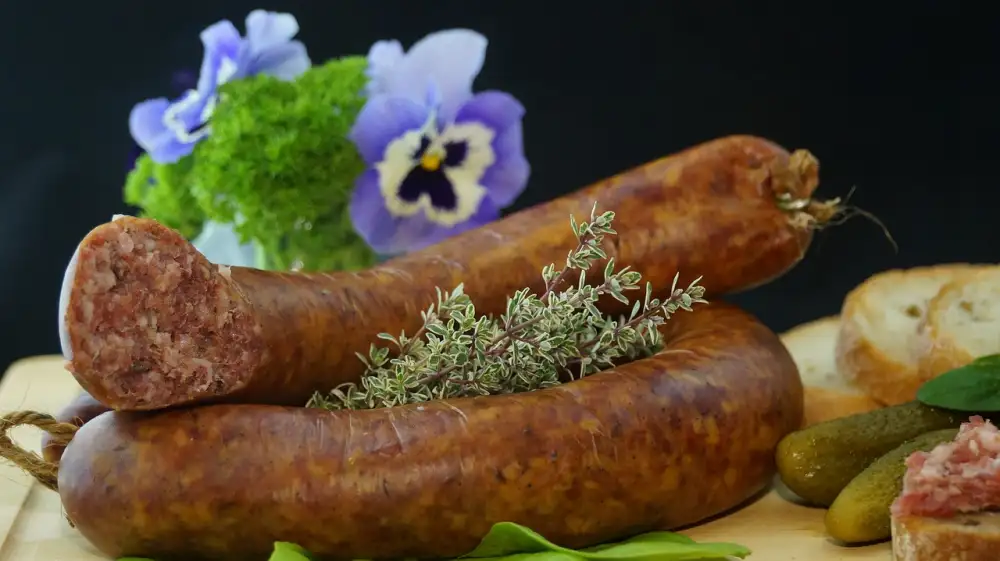Delicious Polish Sausage Recipes: Unleashing the Art of Flavor in Your Kitchen

- History and Origins of Polish Sausage
- Essential Ingredients for Making Polish Sausage
- Traditional Polish Sausage Recipe
- Variations and Regional Styles of Polish Sausage
- Tips and Techniques for Perfecting Polish Sausage
- Serving Suggestions and Pairings for Polish Sausage
- Health Benefits of Polish Sausage
Polish sausage, also known as kielbasa, is a beloved culinary delight that has been enjoyed for centuries. With its rich and savory flavors, it has become a staple in Polish cuisine and has gained popularity worldwide. In this article, we will explore the history and origins of Polish sausage, discover the essential ingredients needed to make it, learn how to prepare a traditional recipe, explore variations and regional styles, and uncover the health benefits of this delectable sausage. Get ready to unleash the art of flavor in your kitchen with these delicious Polish sausage recipes!
History and Origins of Polish Sausage
The history and origins of Polish sausage can be traced back to ancient times. Sausage making was a common practice in Poland, dating back to the 14th century. The tradition of making sausage was passed down from generation to generation, with each family having their own secret recipe.
Polish sausage, also known as kielbasa, is deeply rooted in Polish culture and cuisine. It has become an iconic symbol of Polish culinary heritage. The word "kielbasa" itself means sausage in Polish.
The origins of Polish sausage can be attributed to the abundance of livestock in Poland. In the past, farmers would raise pigs for meat and use every part of the animal to minimize waste. This included using various cuts of meat, spices, and herbs to create flavorful sausages.
Over time, different regions in Poland developed their own unique styles of sausage making. Each region had its preferred blend of spices and methods of preparation. Some popular regional variations include Krakowska (from Krakow), Podlaska (from Podlasie), and Wiejska (a rustic style).
Polish immigrants brought their sausage-making traditions with them when they settled in other parts of the world, including the United States. Today, Polish sausage is enjoyed by people all over the globe.
The rich history and cultural significance behind Polish sausage make it more than just a delicious food item – it represents a connection to tradition and heritage that has been preserved for centuries.
Essential Ingredients for Making Polish Sausage
To create the perfect Polish sausage, you'll need a few essential ingredients. First and foremost, you'll need high-quality pork shoulder or a combination of pork shoulder and beef chuck. The meat should be well-marbled for that juicy and flavorful bite.
Next, you'll need to season the meat with a blend of spices that typically includes garlic, salt, black pepper, marjoram, and sometimes caraway seeds. These spices give Polish sausage its distinctive taste and aroma.
Another crucial ingredient is curing salt or Prague powder #1. This pinkish salt helps preserve the sausage and gives it that characteristic pink color after cooking.
Lastly, you'll need casings to encase the sausage mixture. Natural hog casings are commonly used for Polish sausages as they provide a traditional look and snap when bitten into. However, synthetic casings can also be used if desired.
By using these essential ingredients in your Polish sausage recipe, you'll be on your way to creating a delicious masterpiece bursting with flavor.
Traditional Polish Sausage Recipe
To truly experience the art of flavor, it is essential to master the traditional Polish sausage recipe. Here is a simple yet delicious recipe that will transport your taste buds to the heart of Poland.
Ingredients:
- 2 pounds of pork shoulder, finely ground
- 1/2 pound of beef chuck, finely ground
- 1/4 cup of ice water
- 2 teaspoons of kosher salt
- 1 teaspoon of freshly ground black pepper
- 1 teaspoon of garlic powder
- 1 teaspoon of marjoram
- Natural hog casings
Instructions:
1. In a large mixing bowl, combine the ground pork and beef.
2. Gradually add the ice water while mixing until well incorporated.
3. Add the salt, pepper, garlic powder, and marjoram to the meat mixture. Mix thoroughly.
4. Prepare the natural hog casings by rinsing them in cold water and soaking them in warm water for about 30 minutes.
5. Attach a sausage stuffer or piping bag with a large tip to fill the casings.
6. Stuff the meat mixture into the casings, making sure to avoid air pockets.
7. Twist or tie off the sausages into desired lengths.
8. Prick any visible air pockets with a toothpick or sausage pricker.
9. Place the sausages in a refrigerator for at least 24 hours to allow flavors to meld.
10. Cook on a grill or stovetop until browned and cooked through.
This traditional Polish sausage recipe captures the essence of authentic Polish cuisine. The combination of pork and beef creates a hearty and flavorful sausage that can be enjoyed in various dishes or simply on its own.
Note: It's important to handle raw meat with proper hygiene practices and cook sausages thoroughly before consuming.
Enjoy this classic Polish delicacy and savor every bite of the artful flavors it brings to your kitchen.
Variations and Regional Styles of Polish Sausage
Polish sausage, also known as kielbasa, comes in a variety of delicious variations and regional styles. Each region in Poland has its own unique twist on this beloved sausage, making it a versatile and diverse culinary delight.
In the northern regions of Poland, you'll find the popular Kabanosy sausage. This thin and dry sausage is made from pork and seasoned with garlic, black pepper, and caraway seeds. It is often enjoyed as a snack or appetizer.
Moving to the central regions, we encounter the Krakowska sausage. This smoked sausage is made from pork shoulder and flavored with garlic, marjoram, and nutmeg. Its rich flavor pairs perfectly with sauerkraut or mustard.
In the eastern parts of Poland, you'll discover the Wiejska sausage. This rustic-style sausage is made from a combination of pork and beef, seasoned with garlic, marjoram, and black pepper. It is often grilled or pan-fried for a hearty meal.
Venturing to the southern regions brings us to the famous Oscypek cheese-filled sausages. These unique sausages are made from sheep's milk cheese mixed with minced pork meat. They are then smoked over wood fire for an incredible smoky flavor.
Other regional styles include the Podlaski kielbasa from the northeast, which features a coarser texture and strong garlic flavor. The Slaska kielbasa from Silesia is known for its spicy kick due to added chili peppers.
No matter which variation or regional style you choose, Polish sausages are sure to satisfy your taste buds with their bold flavors and unique combinations of spices. Experimenting with these different styles will allow you to truly appreciate the artistry behind Polish sausage making.
Tips and Techniques for Perfecting Polish Sausage
When it comes to perfecting Polish sausage, there are a few tips and techniques that can take your culinary skills to the next level. Here are some key pointers to keep in mind:
1. Quality ingredients: Start with high-quality meat, preferably a mix of pork and beef. The fat content is crucial for flavor and moisture, so choose cuts with a good balance.
2. Grinding: Invest in a good meat grinder or visit your local butcher to ensure the right texture. Coarsely grind the meat for a traditional sausage, or go for a finer texture if you prefer.
3. Seasoning: Polish sausage relies on simple yet robust flavors like garlic, marjoram, black pepper, and sometimes mustard seeds. Make sure to measure the spices accurately for a well-balanced taste.
4. Mixing: Thoroughly mix the ground meat with the seasonings until everything is evenly distributed. This step ensures consistent flavor throughout each bite.
5. Stuffing: Use natural hog casings for an authentic Polish sausage experience. Soak them in warm water before stuffing to make them pliable and easier to work with.
6. Tying: Properly tying off each link is essential to prevent bursting during cooking. Leave enough space between each link for even cooking and easy slicing later on.
7. Resting: Allow the sausages to rest in the refrigerator overnight before cooking or freezing them. This resting period allows the flavors to meld together and enhances their overall taste.
8. Cooking methods: Polish sausages can be grilled, pan-fried, baked, or simmered depending on personal preference and recipe requirements. Experiment with different methods to find your favorite.
9. Temperature control: Cook sausages over medium heat to avoid excessive charring or drying out while ensuring they are cooked through without being undercooked.
10. Testing doneness: To check if your sausages are cooked thoroughly, use an instant-read thermometer. The internal temperature should reach 160°F (71°C).
By following these tips and techniques, you can elevate your Polish sausage-making skills and create delicious sausages that will impress your family and friends. Enjoy the process and savor the incredible flavors of this beloved culinary tradition.
Serving Suggestions and Pairings for Polish Sausage
When it comes to serving Polish sausage, the possibilities are endless. This flavorful sausage can be enjoyed in a variety of ways, whether as the star ingredient in a main dish or as a delicious addition to appetizers and side dishes.
One classic way to serve Polish sausage is by grilling or pan-frying it and serving it on a bun with mustard and sauerkraut. This creates a mouthwatering Polish sausage sandwich that is perfect for casual lunches or picnics.
Another popular option is to incorporate Polish sausage into hearty stews and soups. Its rich flavor adds depth and complexity to dishes like borscht, cabbage soup, or bean stew. The sausage pairs well with vegetables like potatoes, carrots, and onions, creating a comforting and satisfying meal.
For those looking for lighter options, sliced Polish sausage can be used as a topping for pizzas or added to salads for an extra burst of flavor. It can also be diced and added to omelets or scrambled eggs for a hearty breakfast.
When it comes to pairings, Polish sausage goes well with a variety of flavors. It complements tangy condiments like mustard or horseradish, adding a kick of spice. It also pairs well with pickled vegetables such as sauerkraut or pickles, balancing out the richness of the sausage.
In terms of beverages, Polish sausage pairs nicely with beer or cider. The crispness of these drinks helps cut through the richness of the meat and enhances its flavors. For non-alcoholic options, sparkling water or lemonade can provide a refreshing contrast.
Whether you choose to serve Polish sausage in traditional recipes or experiment with new combinations, one thing is certain: it will always bring an explosion of flavor to your table. So go ahead and explore the many ways you can enjoy this culinary masterpiece!
Health Benefits of Polish Sausage
While Polish sausage is known for its delicious flavor, it also offers some surprising health benefits. Here are a few reasons why indulging in this tasty treat can actually be good for you:
1. Protein Powerhouse: Polish sausage is packed with protein, which is essential for building and repairing tissues in the body. It provides a substantial amount of amino acids that help support muscle growth and development.
2. Rich in Vitamins and Minerals: This sausage contains several important vitamins and minerals, including vitamin B12, zinc, iron, and selenium. These nutrients play a crucial role in maintaining a healthy immune system, promoting energy production, and supporting overall well-being.
3. Good Source of Healthy Fats: While Polish sausage does contain fat, it is typically made from high-quality cuts of meat that provide beneficial fats like monounsaturated fats and omega-3 fatty acids. These fats have been linked to heart health and may help reduce the risk of certain chronic diseases.
4. Energy Boosting: The combination of protein, healthy fats, and carbohydrates found in Polish sausage can provide a sustained release of energy throughout the day. This makes it an excellent choice for those needing an energy boost or participating in physical activities.
5. Antioxidant Properties: Some variations of Polish sausage include ingredients like garlic or spices that offer antioxidant properties. Antioxidants help protect against oxidative stress and inflammation in the body.
It's important to note that moderation is key when enjoying Polish sausage due to its higher sodium content. However, when consumed as part of a balanced diet, incorporating this flavorful delicacy can add nutritional value to your meals while satisfying your taste buds.
In conclusion, Polish sausage recipes offer a delightful journey into the world of flavor. With its rich history and diverse regional styles, making Polish sausage is truly an art form. By using essential ingredients and following traditional techniques, you can create mouthwatering sausages that will impress your family and friends. Don't be afraid to experiment with different variations and pairings to enhance the flavors even further. And remember, while indulging in the deliciousness of Polish sausage, you can also enjoy its health benefits. So why not unleash your culinary creativity and embark on the art of Polish sausage making in your kitchen today?
Published: 03. 12. 2023
Category: Food



